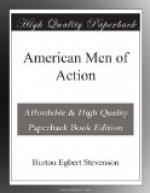The Confederacy was glad to get him, gave him the rank of captain and put him in charge of the work at the Norfolk, Virginia, navy-yard. The most important business going forward there was the reconstruction of the United States frigate, Merrimac. This consisted in building above her berth-deck sloping bulwarks seven feet high, covered with four inches of iron, and pierced for ten guns. To her bow, about two feet under water, a cast-iron ram was attached, and on the eighth of March, she cast loose from her moorings and started down the river. She was scarcely complete, her crew had never been drilled, she had never fired a gun, nor had her engines made a single revolution, while the ship itself was merely a bold experiment, which had never made a trial trip. Yet Buchanan, on reaching Hampton Roads, headed straight for the Union fleet.
There, as soon as the identity of the stranger was discovered, hurried preparations for battle were made. Decks were cleared, magazines opened, and guns loaded, and as soon as the Merrimac was in range, the Union ships and shore batteries opened upon her, but such projectiles as struck her, glanced harmlessly from her iron mail. Not until she was quite near the Cumberland did the Merrimac return the fire. Then she opened her bow-port and sent a seven-inch shell through the Cumberland’s quarter. The Cumberland answered with a broadside which would have blown any wooden vessel out of the water, but which affected the Merrimac not at all. Buchanan had determined to test the power of his ram, and keeping on at full speed, crashed into the Cumberland’s side. Then he backed out, leaving a yawning chasm, through which the water poured into the doomed ship. She settled rapidly and sank with a roar, her crew firing her guns to the last moment.
The Merrimac then turned her attention to the Congress, with such deadly effect that that vessel was forced to surrender after an hour’s fighting, in which she was repeatedly hulled and set on fire. Most of her crew escaped to the shore, and the Confederates completed her destruction by firing hot shot into her. Evening was at hand by this time, and the Merrimac withdrew, intending to destroy the other ships in the harbor next morning.
So ended the most disastrous day in the history of the United States navy. Two ships were lost, and over three hundred men killed or wounded. On the Merrimac, two had been killed and eight wounded, but the vessel herself, though she had been the target for more than a hundred heavy guns, was practically uninjured and as dangerous as ever.
Among the wounded was Captain Buchanan, who was forced to relinquish the command of the Merrimac. For his gallantry, he was thanked by the Confederate Congress, and promoted to full admiral and senior officer of the Confederate navy. As soon as he recovered from his wound, he was placed in charge of the naval defenses of Mobile, Alabama, and there superintended the construction of the ram Tennessee, which he commanded during the action with Farragut two years later. His handling of the vessel was daring almost to madness, but she became disabled and was forced to surrender. Buchanan was taken prisoner, and never again took part in any naval action.




